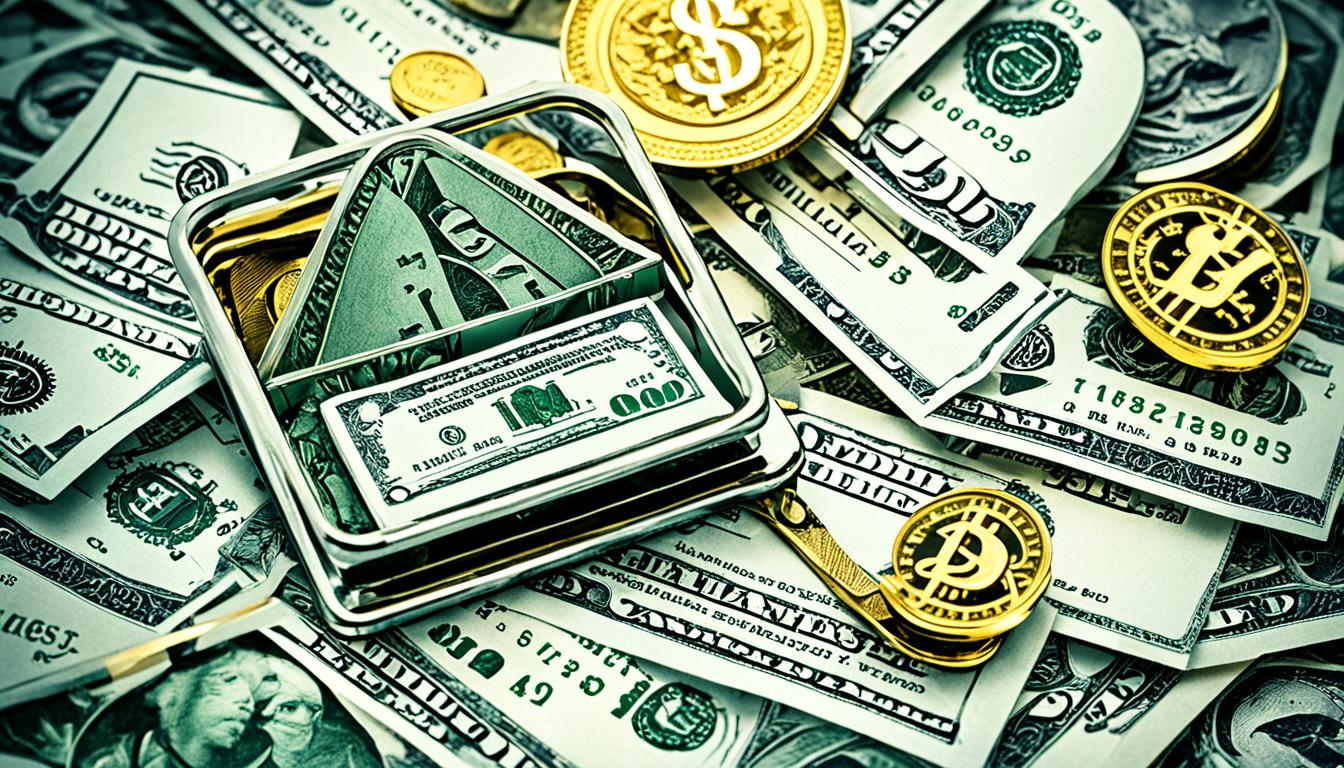Are you aware that incorporating precious metals investment can offer stability and security to your investment portfolio?
Before diving into this lucrative investment option, it’s crucial to ask yourself the right questions to make informed choices.
Whether you are a seasoned investor or a novice, understanding the ins and outs of investing in precious metals is paramount to your success.
In this article, we will walk you through the essential questions to ask before investing in precious metals, helping you navigate this investment option with confidence.
Key Takeaways:
- Investing in precious metals can provide stability and security to your investment portfolio.
- Asking the right questions before investing is crucial to make informed decisions.
- Understanding the ins and outs of investing in precious metals is paramount to your success.
Physical, Digital, or Paper?
When considering investments in precious metals, one of the initial decisions to make is the form in which to invest. Physical precious metals, such as coins and bars, offer direct ownership title and the security of owning a tangible asset. These forms of investment provide individuals with the reassurance of holding an asset that they can physically handle.
For those looking for more convenient options, digital gold and physically-backed exchange-traded offerings are viable alternatives. However, it’s important to ensure that these options provide ownership title and the ability to exchange them for physical metal. This enables investors to have confidence in the legitimacy and long-term value of their investment.
On the other hand, there are forms of paper gold such as gold certificates and futures contracts. These options do not provide ownership title and can be risky, particularly in the event of issuer default. Investing in paper gold carries the potential for counterparty risk and may not offer the same level of security as physical or digital investments.
It is essential for investors to carefully consider the advantages and potential risks associated with each option before making a decision.
Benefits of Physical Precious Metals:
- Direct ownership title
- Tangible asset
- Security
Benefits of Digital Gold:
- Convenience
- Flexibility
- Ability to exchange for physical metal
Disadvantages of Paper Gold:
- No ownership title
- Risk of issuer default
- Potential for counterparty risk
The image below illustrates the different forms of precious metal investments:
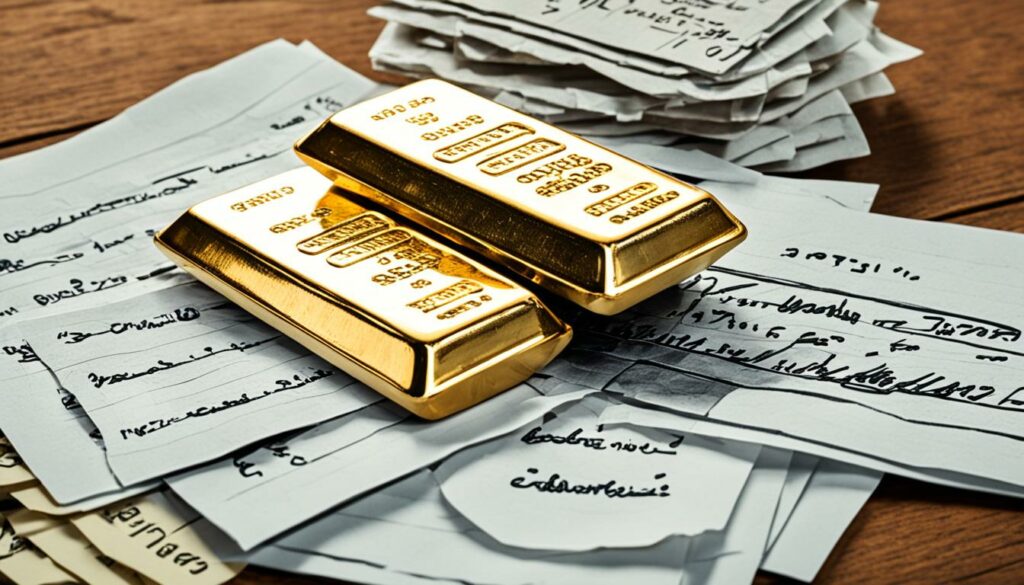
Allocated or Unallocated Metals?
When considering investing in precious metals, one important factor to take into account is whether to opt for allocated or unallocated metals. This decision plays a crucial role in ensuring investor safety and protecting their assets.
Allocated precious metals offer the highest degree of investor safety. In this arrangement, the metals are segregated, which means they are held separately and cannot be mixed or used by anyone else. Ownership title is established, providing investors with a legal claim to a specific quantity of precious metals. This essentially means that the metal belongs to the investor and cannot be lent or leased to third parties. Allocated metals provide a tangible asset in the investor’s name, offering peace of mind and security.
On the other hand, unallocated precious metals introduce a certain level of counterparty risk. In this scenario, the ownership title is not secured by the investor. Unallocated metals represent a pool of precious metals held by a financial institution or dealer. The investor holds an unsecured claim on the metal, making them vulnerable to the financial stability of the institution. In certain situations, investor claims may exceed the total amount of underlying metal, posing a potential risk.
Example
“Choosing allocated metals provides an added layer of safety and assurance for investors,” says John Smith, a renowned precious metals expert. “With allocated metals, you have ownership title and physical control over your investment.”
Ultimately, the decision between allocated and unallocated metals depends on the investor’s risk tolerance and preference for direct ownership. Allocated metals offer the highest level of safety and control, ensuring that the investor’s precious metals are fully accounted for and in their possession. On the other hand, unallocated metals may carry additional risk due to the lack of ownership title and potential exposure to counterparty risk.
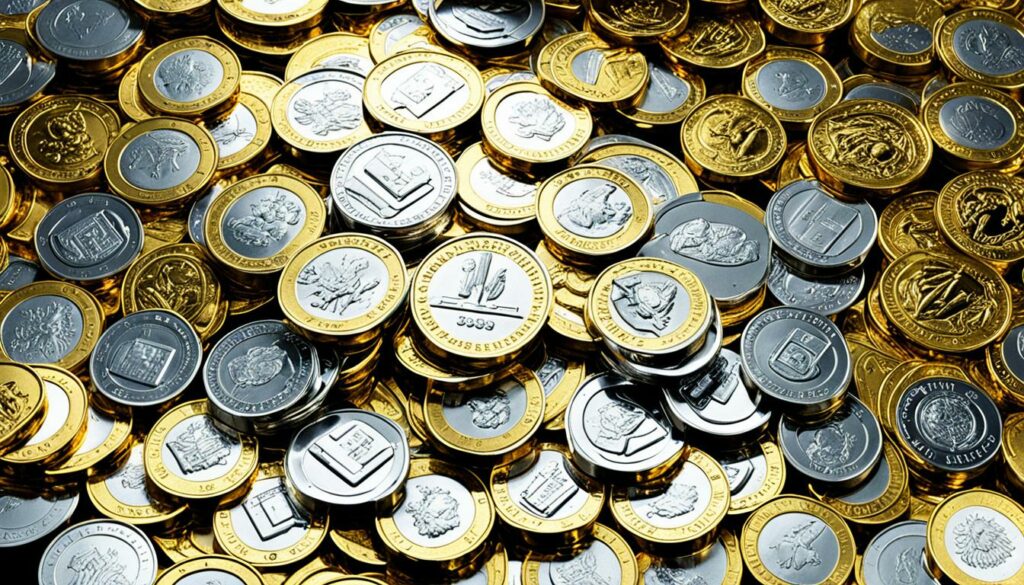
Markup to Spot Metals Prices
When investing in precious metals, it’s important to consider the mark-up to spot metals prices. The mark-up refers to the additional cost you’ll pay above the spot price for coins and bars.
Depending on factors such as rarity, purity, volume, and dealer inventories, the mark-up can range from 2% to 8%. It’s essential to compare mark-ups between different sellers to ensure you’re getting the best value for your investment.
For investors looking for more convenient options, exchange-traded funds (ETFs) are typically purchased and sold at prices close to the spot price. However, ETFs do charge annual management fees.
Closed-end funds, on the other hand, can trade at significant discounts to the underlying spot price. Some closed-end funds may even allow you to redeem shares for physical metal. These funds can be an attractive option for investors looking for potential bargains in the market.
Before making a decision, it’s crucial to weigh the mark-up of physical metals against the fees associated with ETFs and the potential discounts of closed-end funds. Consider your investment goals, liquidity needs, and risk tolerance when choosing the best investment vehicle for your precious metals portfolio.
Below is an example table illustrating the mark-up, spot metals prices, and investment options:
| Investment Option | Markup Percentage | Spot Metals Prices |
|---|---|---|
| Physical Gold Coins and Bars | 2% – 8% | N/A |
| ETFs | Varies | Close to spot price |
| Closed-end Funds | Discounted | Below spot price |
Providing Transparency in Pricing
When evaluating mark-ups and pricing, it’s essential to work with reputable dealers and financial institutions. They should provide transparency in their pricing and clearly communicate the costs associated with your investment.

Understanding the mark-up to spot metals prices can help you make more informed decisions and maximize the value of your investments in gold coins, gold bars, ETFs, and closed-end funds.
Storing Your Precious Metals
When investing in precious metals, it’s crucial to consider secure storage options to mitigate risk and safeguard your investment. Reputable storage providers offer insured storage solutions, providing peace of mind for investors.
Insured storage ensures that your precious metals are protected against theft, damage, and loss. This provides an extra layer of security, especially for investors who hold a significant amount of precious metals.
Counterparty risk is an important factor to consider when choosing a storage custodian. It refers to the potential risk associated with the custodian or storage provider becoming insolvent or defaulting on their obligations. To mitigate this risk, it’s advisable to avoid storage custodians that are subsidiaries of leveraged financial institutions.
“Investors should choose storage custodians that prioritize security and have a proven track record in protecting clients’ precious metals holdings,” advises The Liberty Portfolio, a leading industry expert.
By opting for storage custodians with a strong reputation and a focus on security, investors can minimize counterparty risk and have confidence in the safety of their precious metals.
Storage Options for ETFs and Closed-End Funds
When investing in ETFs and closed-end funds, it’s essential to consider the storage custodians employed by these investment vehicles. The storage custodians play a crucial role in ensuring the physical integrity of the underlying precious metals.
Investors should inquire about the security measures implemented by the storage custodians used by ETFs and closed-end funds. It’s recommended to choose funds that partner with established storage custodians known for their commitment to security and adherence to industry best practices.
Additionally, it’s important to review the custodian’s insurance policy to understand the extent of coverage provided. This will ensure that your investment is adequately protected in the event of a loss or damage to the stored precious metals.
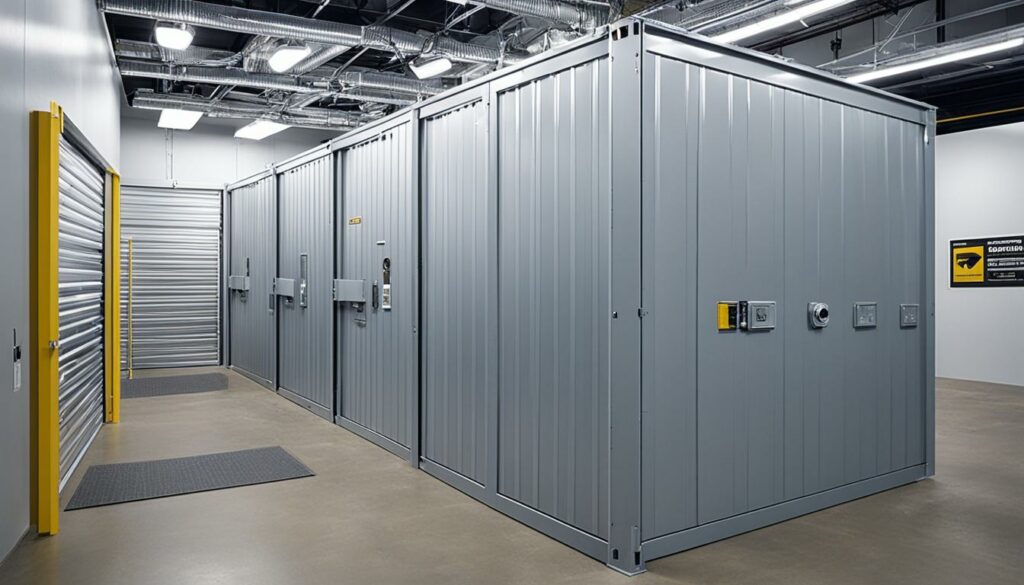
Comparing Storage Fees and Services
When evaluating storage options, it’s crucial to consider the fees associated with different storage providers. While insured storage offers peace of mind, investors should also assess the cost-effectiveness of storage fees.
Some storage providers may charge higher fees for additional security measures or enhanced insurance coverage. It’s important to strike a balance between the level of security desired and the associated costs. Conducting thorough research and comparing fees and services offered by different storage providers can help investors make informed decisions.
Investors should carefully weigh the cost of storage against the level of security provided to find the most suitable option for their precious metals holdings.
Storage Fees:
- On average, gold IRA storage fees range from $50 to $250 annually, but some custodians may charge more or less[1].
- For nonsegregated storage, the cost is usually about $100 per year, while segregated storage may be $150 to $180 per year[3].
- The cost of a precious metals IRA is $80 for maintenance and anywhere from $150 to $225 for storage with Noble Gold[3].
- Accuplan has some of the lowest fees in the industry – a $50 setup fee, $195 annual fee, and $12 monthly storage fee per precious metals holding within an IRA[4].
Factors Influencing Fees:
- The provider you choose, the type of metal you hold, and your service package may all affect costs[2].
- Storing silver is more expensive than gold because you need a much higher storage volume for the same dollar amount[2].
- Some companies offer optional services that can increase annual fees[2].
Ways to Minimize Fees:
- Shop around, get quotes from several companies, and compare fee structures before choosing a custodian[2].
- Some companies offer fee waivers or discounts for the first year. For example, American Hartford Gold will waive shipping and storage fees for the first year on qualifying purchases of $10,000 or more[3].
- Noble Gold covers fees for the first year for most new IRA customers[3].
Additional Services:
- Accuplan offers a mistake-free setup process, certified and insured storage, dual verification of delivery and storage, and liquidation services when needed[4].
- Birch Gold Group storage options include full insurance for up to $1 billion against all risks[3].
In summary, gold IRA storage fees and services vary by provider, but you can expect to pay $50-$250 annually on average. Comparing custodians, taking advantage of promotions, and considering the additional services offered can help you find the best value and minimize fees for your gold IRA.
Citations:
[1] https://www.linkedin.com/pulse/best-gold-ira-companies-low-fees-annette-lode
[2] https://www.oxfordgoldgroup.com/articles/how-much-are-gold-ira-fees/
[3] https://iracompanies.gold
[4] https://www.accuplan.net/self-directed-ira/investments/precious-metals/
[5] https://www.americanbullion.com/gold-ira/home-storage/
[6] https://www.bptrends.com/goldco-vs-noble-gold/
[7] https://www.linkedin.com/pulse/securing-your-wealth-gold-ira-storage-solutions-best-practices-tom-4i24e
[8] https://www.cnbc.com/select/best-gold-ira-companies/
[9] https://www.birchgold.com/precious-metals-ira/gold-home-storage-iras/
[10] https://www.cbsnews.com/news/where-to-keep-your-gold-ira/
[11] https://www.jpost.com/business-and-innovation/article-794217
[12] https://www.monetarygold.com/gold-silver-ira/private-storage-ira/
[13] https://www.usatoday.com/story/special/contributor-content/2023/10/18/investing-in-a-gold-ira-pros-and-cons-explained/71227505007/
[14] https://goldco.com/gold-ira-storage-at-home/
[15] https://www.jmbullion.com/investing-guide/taxes-reporting-iras/precious-metals-ira-cost/
[16] https://www.vantageiras.com/knowledgebase/fees-precious-metals-ira
[17] https://www.santacruzsentinel.com/2024/04/16/best-gold-ira-companies/
[18] https://www.linkedin.com/pulse/gold-ira-vs-physical-annette-lode
[19] https://www.forbes.com/advisor/retirement/precious-metal-ira-gold-silver/
[20] https://www.bptrends.com/gold-ira-vs-roth-ira/
Overall, choosing a secure storage solution is vital for protecting your investment in precious metals. Insured storage and selecting reputable storage custodians can help mitigate counterparty risk and ensure the safekeeping of your precious metals.
Taking Delivery of Your Precious Metals
If you prefer to have physical possession of your precious metals, investing in coins and bars is the way to go. You can take direct physical delivery of these assets. However, if you invest in ETFs, you won’t have the option to take physical delivery. Some closed-end funds do allow investors to take delivery of the underlying metal. Consider your preference for physical possession when choosing an investment vehicle.
When it comes to owning precious metals, the physical delivery of coins and bars provides a sense of security and control. By opting for physical delivery, you can hold the tangible assets in your hands, ensuring you have direct ownership. This can be especially appealing for those who value the physical presence of their investments and want to safeguard against any potential risks associated with digital or paper forms of ownership.
Investors who choose to invest in ETFs or closed-end funds, on the other hand, should be aware that physical delivery is not an option. These investment vehicles are designed to provide exposure to precious metals through financial instruments rather than physical possession. The focus here is on the convenience and flexibility offered by these investment options, with the ease of buying and selling shares on exchanges.
Investing in coins and bars allows physical delivery and direct ownership, providing a tangible sense of security. ETFs and closed-end funds, while not offering physical delivery, offer convenience and flexibility for those who prefer financial instruments.
It’s worth noting that for investors who still desire physical possession of their precious metals while investing in closed-end funds, certain options exist. Select closed-end funds provide the ability to take delivery of the underlying metal, offering a middle ground for investors who want the convenience of funds alongside the assurance of possessing the physical asset.
Table: Comparison of Options for Physical Delivery
| Investment Vehicle | Physical Delivery Option |
|---|---|
| Coins and Bars | Yes |
| ETFs | No |
| Closed-End Funds | Some Funds |
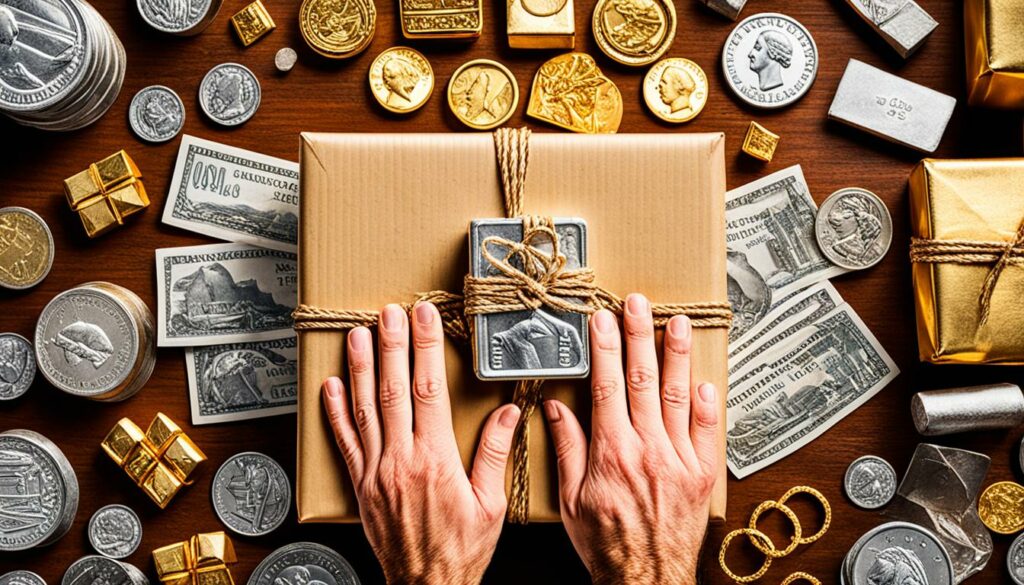
Ongoing Costs of Precious Metal Ownership
Owning physical bars and coins involves several ongoing costs that investors need to consider.
Insurance costs: When you own physical precious metals, it’s crucial to protect your investment with insurance. Insurance costs can vary depending on factors such as the value and location of your stored metals. It’s essential to research reputable insurance providers and determine the coverage that suits your needs.
Storage costs: Storing precious metals securely is vital to safeguarding your investment. Whether you choose a private vault, a bank safe deposit box, or a third-party storage facility, there will be storage costs associated. These costs cover the maintenance and security measures provided by the storage provider.
It’s worth noting that storage costs for allocated metals may be higher due to the additional security measures, such as auditing and individual storage spaces, provided by storage custodians.
Management fees: If you opt for investment vehicles such as exchange-traded funds (ETFs) or closed-end funds, you’ll encounter management fees. These fees cover various expenses related to the fund’s operation, including administration, custody, and marketing. It’s important to compare management fees across different funds to ensure you choose the one that aligns with your investment strategy and goals.
When assessing the costs of ownership, it’s essential to evaluate the total mark-up and mark-down costs associated with physical ownership compared to the management fees for ETFs and closed-end funds. Consider your investment holding period and the potential impact on overall returns.
To summarize, owning physical precious metals entails insurance costs, storage costs, and management fees. These ongoing costs are crucial factors to consider when deciding on the most suitable investment approach for your precious metal holdings.
Liquidity of Your Investment
When considering your investment in precious metals, liquidity is an important factor to take into account. Liquidity refers to the ease and speed with which you can buy or sell your investment.
Selling coins and bars can sometimes be a cumbersome process. You may need to find a reputable buyer, negotiate a price, and arrange for secure transportation. This can be time-consuming and may not always yield the desired results.
On the other hand, investing in exchange-traded funds (ETFs) or closed-end funds can offer greater liquidity. These investment vehicles can be bought and sold throughout the trading day on exchanges. This means that you can quickly and easily adjust your investment position, taking advantage of market fluctuations or addressing your financial needs.
It’s important to consider the convenience and settlement period when determining the liquidity of your investment. While selling coins and bars might take longer, ETFs and closed-end funds can provide a more agile and accessible way to manage your precious metal portfolio.
Comparing Liquidity: Selling Coins and Bars vs. ETFs and Closed-End Funds
| Liquidity Aspect | Selling Coins and Bars | ETFs and Closed-End Funds |
|---|---|---|
| Process | Requires finding a buyer, negotiating, and arranging secure transportation. | Can be bought and sold throughout the trading day on exchanges. |
| Speed | Selling coins and bars can take longer due to the involved process. | ETFs and closed-end funds offer faster transactions. |
| Flexibility | May not provide immediate flexibility when adjusting your investment position. | Allows for quick adjustments to investment positions. |
As seen in the table above, ETFs and closed-end funds generally offer greater liquidity compared to selling physical coins and bars. Considering the convenience and agility of these investment vehicles, they may be a preferable option for investors looking to quickly convert their precious metals holdings into liquid assets.
Remember, when making investment decisions, it’s crucial to understand the potential benefits and risks associated with each option, including liquidity.

Conclusion
Investing in precious metals can greatly enhance the diversification and security of a well-diversified investment portfolio. Before making any investment decisions, it is crucial to ask the right questions and thoroughly consider various factors. By evaluating options such as physical versus digital investments, allocated versus unallocated metals, mark-ups and ongoing costs, storage choices, delivery preferences, and liquidity, investors can make informed choices and ensure a smart and secure investment in precious metals.
One of the key benefits of investing in precious metals is the ability to hedge against market volatility and currency fluctuations. By including these assets, individuals can diversify their investment holdings and mitigate risk. However, it is important to carefully assess the different forms of precious metals investment, such as physical coins and bars, digital gold, or paper gold, and weigh the advantages and potential drawbacks of each option.
Furthermore, studying the available storage options and understanding the costs associated with owning, insuring, and storing precious metals is essential. Additionally, considering the liquidity and ease of buying and selling different investment vehicles can greatly impact an investor’s flexibility and ability to react to market conditions.
To make the most of investing in precious metals and achieve a well-diversified portfolio, individuals should consult with reputable financial advisors, keep abreast of market trends, and continuously re-evaluate their investment strategy. By harnessing the benefits of precious metals and carefully navigating the associated considerations, investors can achieve both financial security and peace of mind.
FAQ
What are the questions to ask before investing in precious metals?
What are the options for investing in precious metals?
How do I determine the safety of my precious metal investment?
What are the mark-ups and fees associated with investing in precious metals?
How should I store my precious metals?
Can I take physical delivery of my precious metals?
What are the ongoing costs associated with owning precious metals?
How liquid are precious metal investments?
Is investing in precious metals a valuable addition to a portfolio?
Helen brings a wealth of experience in investment strategy and a deep passion for helping individuals achieve their retirement goals. With a keen understanding of market dynamics, Helen has been instrumental in shaping the vision and direction of Gold IRA Markets. She specializes in creating innovative solutions that align with our clients’ long-term investment objectives.
